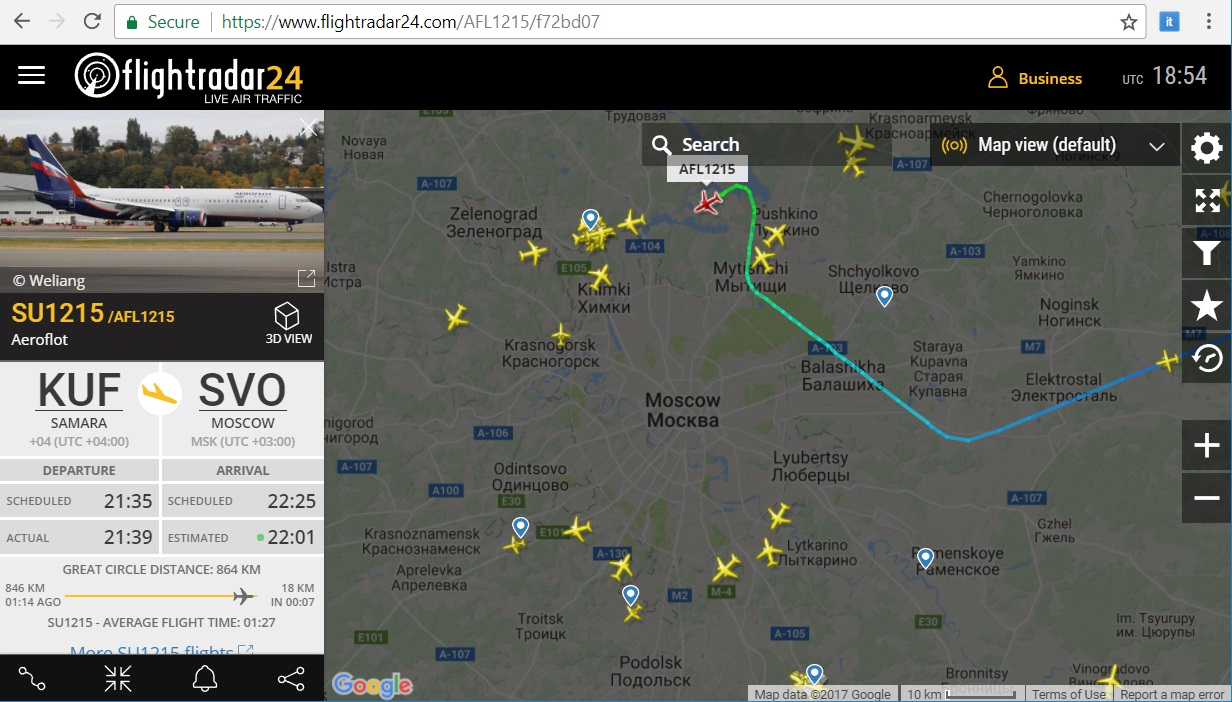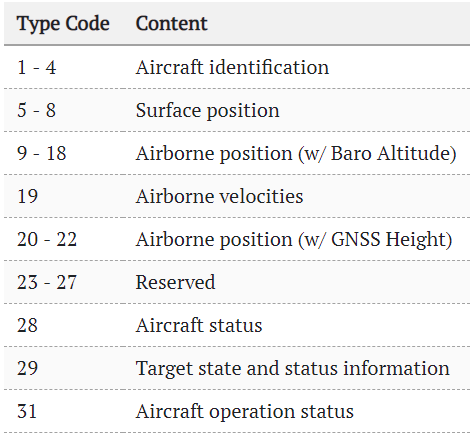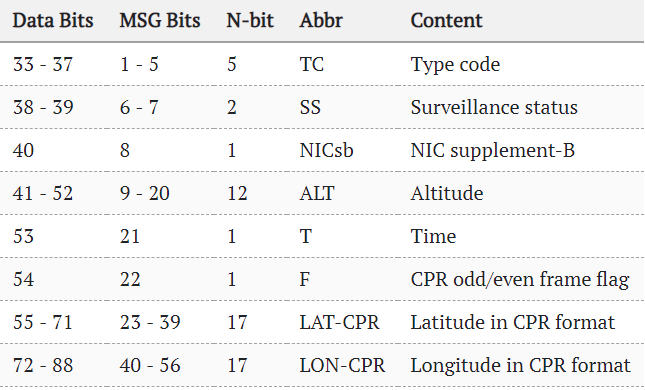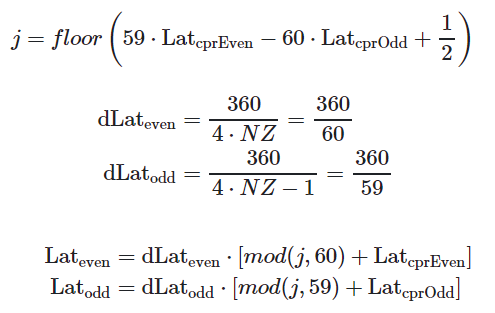Flightradar24 - how does it work? Part 2, ADS-B Protocol
Hi Habr. Probably everyone who has ever met or accompanied relatives or friends on an airplane used the free Flightradar24 service. This is a very convenient way to track the position of the aircraft in real time.

The first part described the principle of operation of such an online service. Now we will go further, and find out what data is transmitted and received from the aircraft to the receiving station, and decode them independently using Python.
Obviously, the data about the aircraft is not transmitted so that users can see them on their smartphones. The system is called ADS – B (Automatic dependent surveillance — broadcast), and is used to automatically transmit aircraft information to a control center — its identifier, coordinates, direction, speed, altitude and other data are transmitted. Previously, before the advent of such systems, the dispatcher could only see a point on the radar. This was not enough when there were too many planes.
Technically, ADS-B consists of a transmitter on an aircraft that periodically sends packets with information at a fairly high frequency of 1090 MHz (there are other modes, but they are not so interesting to us, because the coordinates are transmitted only here). Of course, in addition to the transmitter, there is also a receiver somewhere at the airport, but for us, as for users, our own receiver is interesting.
By the way, for comparison, the first such system, Airnav Radarbox, designed for ordinary users, appeared in 2007, and cost about $ 900, about $ 250 a year was worth a subscription to network services.

You can read the reviews of those first Russian owners on the radioscanner forum . Now that RTL-SDR receivers have become widely available, a similar device can be assembled for $ 30, more about this was inthe first part . We will proceed to the protocol itself - let's see how it works.
To get started, the signal needs to be recorded. The entire signal has a duration of only 120 microseconds, therefore, in order to comfortably disassemble its components, an SDR receiver with a sampling frequency of at least 5 MHz is desirable.

After recording, we get a WAV file with a sampling frequency of 5,000,000 samples / sec, 30 seconds of such a recording “weigh” about 500 MB. Listening to it with a media player is, of course, useless - the file does not contain sound, but a directly digitized radio signal - this is how Software Defined Radio works.
We will open and process the file using Python. Those who wish to experiment on their own can download the sample recording from the link .
Download the file and see what's inside.
Result: we see obvious “impulses” against the background of noise.

Each “impulse” is a signal whose structure is clearly visible if you increase the resolution on the graph.

As you can see, the picture is consistent with what is described in the description above. You can start processing the data.
First you need to get a bitstream. The signal itself is encoded using manchester encoding:

It is easy to get real “0” and “1” from the difference in levels in nibbles.
The structure of the signal itself has the following form:

Consider the fields in more detail.
DF (Downlink Format, 5 bits) - defines the type of message. There are several types of them:

( table source )
We are only interested in type DF17, because it contains the coordinates of the aircraft.
ICAO (24 bits) is an international unique aircraft code. You can check the aircraft by its code on the website (unfortunately, the author has stopped updating the database, but it is still relevant). For example, for the 3c5ee2 code, we have the following information:

Edit: in the commentary on the article, the ICAO code is described in more detail, I recommend that you familiarize yourself with those interested.
DATA(56 or 112 bits) - actually the data that we will decode. The first 5 bits of data is the Type Code field containing the subtype of the stored data (not to be confused with DF). There are quite a few of these types:

( table source )
Let's look at a few sample packages.
Aircraft identification
Example in binary form:
00100 011 000101 010111 000111 110111 110001 111000 Data
fields:
TC = 00100b = 4, each C1-C8 character contains codes that correspond to the indices in the line:
#ABCDEFGHIJKLMNOPQRSTUVWXYZ ##### _ ############### 0123456789 ######
Decoding line, it is easy to get the airplane code: EWG7184
Airborne position
If the name is simple, then the coordinates are more complicated. They are transmitted in the form of 2x, even and odd frames. Field code TC = 01011b = 11.

Example of even and odd packets:
The calculation of coordinates itself takes place according to a rather clever formula:

( source )
I am not a GIS specialist, so I don’t know where it comes from . Who is in the know, write in the comments.
Altitude is considered easier - depending on a particular bit, it can appear either as a multiple of 25 or 100 feet.
Airborne Velocity
Package with TC = 19. What is interesting here is that the speed can be either accurate, relative to the ground (Ground Speed), or air, as measured by an airplane sensor (Airspeed). Many different fields are still being transmitted:

( source )
As you can see, the ADS-B technology has become an interesting symbiosis when a standard comes in handy not only for professionals, but also for ordinary users. But of course, the key role in this was played by the cheapening of the technology of digital SDR receivers, which allows the device to receive signals with a frequency above gigahertz literally “for a penny”.
In the standard itself, of course, much more than anything. Those interested can see the PDF on the ICAO page or visit the site already mentioned above .
It is unlikely that many of the above will come in handy, but at least the general idea of how this works, I hope, remains.
By the way, a ready-made decoder in Python already exists, it can be studied here. And the owners of SDR receivers can assemble and run the finished ADS-B decoder from the page , more about this in the first part .
The source code of the parser described in the article is given under the cut. This is a test example that does not pretend to be production, but something works in it, and you can parse the file recorded above.
I hope someone was interested, thanks for your attention.

The first part described the principle of operation of such an online service. Now we will go further, and find out what data is transmitted and received from the aircraft to the receiving station, and decode them independently using Python.
History
Obviously, the data about the aircraft is not transmitted so that users can see them on their smartphones. The system is called ADS – B (Automatic dependent surveillance — broadcast), and is used to automatically transmit aircraft information to a control center — its identifier, coordinates, direction, speed, altitude and other data are transmitted. Previously, before the advent of such systems, the dispatcher could only see a point on the radar. This was not enough when there were too many planes.
Technically, ADS-B consists of a transmitter on an aircraft that periodically sends packets with information at a fairly high frequency of 1090 MHz (there are other modes, but they are not so interesting to us, because the coordinates are transmitted only here). Of course, in addition to the transmitter, there is also a receiver somewhere at the airport, but for us, as for users, our own receiver is interesting.
By the way, for comparison, the first such system, Airnav Radarbox, designed for ordinary users, appeared in 2007, and cost about $ 900, about $ 250 a year was worth a subscription to network services.

You can read the reviews of those first Russian owners on the radioscanner forum . Now that RTL-SDR receivers have become widely available, a similar device can be assembled for $ 30, more about this was inthe first part . We will proceed to the protocol itself - let's see how it works.
Receiving signals
To get started, the signal needs to be recorded. The entire signal has a duration of only 120 microseconds, therefore, in order to comfortably disassemble its components, an SDR receiver with a sampling frequency of at least 5 MHz is desirable.

After recording, we get a WAV file with a sampling frequency of 5,000,000 samples / sec, 30 seconds of such a recording “weigh” about 500 MB. Listening to it with a media player is, of course, useless - the file does not contain sound, but a directly digitized radio signal - this is how Software Defined Radio works.
We will open and process the file using Python. Those who wish to experiment on their own can download the sample recording from the link .
Download the file and see what's inside.
from scipy.io import wavfile
import matplotlib.pyplot as plt
import numpy as np
fs, data = wavfile.read("adsb_20190311_191728Z_1090000kHz_RF.wav")
data = data.astype(float)
I, Q = data[:, 0], data[:, 1]
A = np.sqrt(I*I + Q*Q)
plt.plot(A)
plt.show()
Result: we see obvious “impulses” against the background of noise.

Each “impulse” is a signal whose structure is clearly visible if you increase the resolution on the graph.

As you can see, the picture is consistent with what is described in the description above. You can start processing the data.
Decoding
First you need to get a bitstream. The signal itself is encoded using manchester encoding:

It is easy to get real “0” and “1” from the difference in levels in nibbles.
bits_str = ""
for p in range(8):
pos = start_data + bit_len*p
p1, p2 = A[pos: pos + bit_len/2], A[pos + bit_len/2: pos + bit_len]
avg1, avg2 = np.average(p1), np.average(p2)
if avg1 < avg2:
bits_str += "0"
elif avg1 > avg2:
bits_str += "1"
The structure of the signal itself has the following form:

Consider the fields in more detail.
DF (Downlink Format, 5 bits) - defines the type of message. There are several types of them:

( table source )
We are only interested in type DF17, because it contains the coordinates of the aircraft.
ICAO (24 bits) is an international unique aircraft code. You can check the aircraft by its code on the website (unfortunately, the author has stopped updating the database, but it is still relevant). For example, for the 3c5ee2 code, we have the following information:

Edit: in the commentary on the article, the ICAO code is described in more detail, I recommend that you familiarize yourself with those interested.
DATA(56 or 112 bits) - actually the data that we will decode. The first 5 bits of data is the Type Code field containing the subtype of the stored data (not to be confused with DF). There are quite a few of these types:

( table source )
Let's look at a few sample packages.
Aircraft identification
Example in binary form:
00100 011 000101 010111 000111 110111 110001 111000 Data
fields:
+------+------+------+------+------+------+------+------+------+------+
| TC,5 | EC,3 | C1,6 | C2,6 | C3,6 | C4,6 | C5,6 | C6,6 | C7,6 | C8,6 |
+------+------+------+------+------+------+------+------+------+------+
TC = 00100b = 4, each C1-C8 character contains codes that correspond to the indices in the line:
#ABCDEFGHIJKLMNOPQRSTUVWXYZ ##### _ ############### 0123456789 ######
Decoding line, it is easy to get the airplane code: EWG7184
symbols = "#ABCDEFGHIJKLMNOPQRSTUVWXYZ#####_###############0123456789######"
code_str = ""
for p in range(8):
c = int(bits_str[8 + 6*p:8 + 6*(p + 1)], 2)
code_str += symbols[c]
print("Aircraft Identification:", code_str.replace('#', ''))
Airborne position
If the name is simple, then the coordinates are more complicated. They are transmitted in the form of 2x, even and odd frames. Field code TC = 01011b = 11.

Example of even and odd packets:
01011 000 000101110110 00 10111000111001000 10000110101111001
01011 000 000110010000 01 10010011110000110 10000011110001000
The calculation of coordinates itself takes place according to a rather clever formula:

( source )
I am not a GIS specialist, so I don’t know where it comes from . Who is in the know, write in the comments.
Altitude is considered easier - depending on a particular bit, it can appear either as a multiple of 25 or 100 feet.
Airborne Velocity
Package with TC = 19. What is interesting here is that the speed can be either accurate, relative to the ground (Ground Speed), or air, as measured by an airplane sensor (Airspeed). Many different fields are still being transmitted:

( source )
Conclusion
As you can see, the ADS-B technology has become an interesting symbiosis when a standard comes in handy not only for professionals, but also for ordinary users. But of course, the key role in this was played by the cheapening of the technology of digital SDR receivers, which allows the device to receive signals with a frequency above gigahertz literally “for a penny”.
In the standard itself, of course, much more than anything. Those interested can see the PDF on the ICAO page or visit the site already mentioned above .
It is unlikely that many of the above will come in handy, but at least the general idea of how this works, I hope, remains.
By the way, a ready-made decoder in Python already exists, it can be studied here. And the owners of SDR receivers can assemble and run the finished ADS-B decoder from the page , more about this in the first part .
The source code of the parser described in the article is given under the cut. This is a test example that does not pretend to be production, but something works in it, and you can parse the file recorded above.
Source Code (Python)
from __future__ import print_function
from scipy.io import wavfile
from scipy import signal
import matplotlib.pyplot as plt
import numpy as np
import math
import sys
def parse_message(data, start, bit_len):
max_len = bit_len*128
A = data[start:start + max_len]
A = signal.resample(A, 10*max_len)
bits = np.zeros(10*max_len)
bit_len *= 10
start_data = bit_len*8
# Parse first 8 bits
bits_str = ""
for p in range(8):
pos = start_data + bit_len*p
p1, p2 = A[pos: pos + bit_len/2], A[pos + bit_len/2: pos + bit_len]
avg1, avg2 = np.average(p1), np.average(p2)
if avg1 < avg2:
bits_str += "0"
elif avg1 > avg2:
bits_str += "1"
df = int(bits_str[0:5], 2)
# Aircraft address (db - https://junzis.com/adb/?q=3b1c5c )
bits_str = ""
for p in range(8, 32):
pos = start_data + bit_len * p
p1, p2 = A[pos: pos + bit_len / 2], A[pos + bit_len / 2: pos + bit_len]
avg1, avg2 = np.average(p1), np.average(p2)
if avg1 < avg2:
bits_str += "0"
elif avg1 > avg2:
bits_str += "1"
# print "Aircraft address:", bits_str, hex(int(bits_str, 2))
address = hex(int(bits_str, 2))
# Filter specific aircraft (optional)
# if address != "0x3c5ee2":
# return
if df == 16 or df == 17 or df == 18 or df == 19 or df == 20 or df == 21:
# print "Pos:", start, "DF:", msg_type
# Data (56bit)
bits_str = ""
for p in range(32, 88):
pos = start_data + bit_len*p
p1, p2 = A[pos: pos + bit_len/2], A[pos + bit_len/2: pos + bit_len]
avg1, avg2 = np.average(p1), np.average(p2)
if avg1 < avg2:
bits_str += "0"
# bits[pos + bit_len / 2] = 50
elif avg1 > avg2:
bits_str += "1"
# http://www.lll.lu/~edward/edward/adsb/DecodingADSBposition.html
# print "Data:"
# print bits_str[:8], bits_str[8:20], bits_str[20:22], bits_str[22:22+17], bits_str[39:39+17]
# Type Code:
tc, ec = int(bits_str[:5], 2), int(bits_str[5:8], 2)
# print("DF:", df, "TC:", tc)
# 1 - 4 Aircraft identification
# 5 - 8 Surface position
# 9 - 18 Airborne position (w/ Baro Altitude)
# 19 Airborne velocities
if tc >= 1 and tc <= 4: # and (df == 17 or df == 18):
print("Aircraft address:", address)
print("Data:")
print(bits_str[:8], bits_str[8:14], bits_str[14:20], bits_str[20:26], bits_str[26:32], bits_str[32:38], bits_str[38:44])
symbols = "#ABCDEFGHIJKLMNOPQRSTUVWXYZ#####_###############0123456789######"
code_str = ""
for p in range(8):
c = int(bits_str[8 + 6*p:8 + 6*(p + 1)], 2)
code_str += symbols[c]
print("Aircraft Identification:", code_str.replace('#', ''))
print()
if tc == 11:
print("Aircraft address:", address)
print("Data: (11)")
print(bits_str[:8], bits_str[8:20], bits_str[20:22], bits_str[22:22+17], bits_str[39:39+17])
# Bit 22 contains the F flag which indicates which CPR format is used (odd or even)
# First frame has F flag = 0 so is even and the second frame has F flag = 1 so odd
# f = bits_str[21:22]
# print("F:", int(f, 2))
# Altitude
alt1b = bits_str[8:20]
if alt1b[-5] == '1':
bits = alt1b[:-5] + alt1b[-4:]
n = int(bits, 2)
alt_ft = n*25 - 1000
print("Alt (ft)", alt_ft)
# lat_dec = int(bits_str[22:22+17], 2)
# lon_dec = int(bits_str[39:39+17], 2)
# print("Lat/Lon:", lat_dec, lon_dec)
# http://airmetar.main.jp/radio/ADS-B%20Decoding%20Guide.pdf
print()
if tc == 19:
print("Aircraft address:", address)
print("Data:")
# print(bits_str)
print(bits_str[:5], bits_str[5:8], bits_str[8:10], bits_str[10:13], bits_str[13] ,bits_str[14:24], bits_str[24], bits_str[25:35], bits_str[35:36], bits_str[36:65])
subtype = int(bits_str[5:8], 2)
# https://mode-s.org/decode/adsb/airborne-velocity.html
spd, hdg, rocd = -1, -1, -1
if subtype == 1 or subtype == 2:
print("Velocity Subtype 1: Ground speed")
v_ew_sign = int(bits_str[13], 2)
v_ew = int(bits_str[14:24], 2) - 1 # east-west velocity
v_ns_sign = int(bits_str[24], 2)
v_ns = int(bits_str[25:35], 2) - 1 # north-south velocity
v_we = -1*v_ew if v_ew_sign else v_ew
v_sn = -1*v_ns if v_ns_sign else v_ns
spd = math.sqrt(v_sn*v_sn + v_we*v_we) # unit in kts
hdg = math.atan2(v_we, v_sn)
hdg = math.degrees(hdg) # convert to degrees
hdg = hdg if hdg >= 0 else hdg + 360 # no negative val
if subtype == 3:
print("Subtype Subtype 3: Airspeed")
hdg = int(bits_str[14:24], 2)/1024.0*360.0
spd = int(bits_str[25:35], 2)
vr_sign = int(bits_str[36], 2)
vr = int(bits_str[36:45], 2)
rocd = -1*vr if vr_sign else vr # rate of climb/descend
print("Speed (kts):", spd, "Rate:", rocd, "Heading:", hdg)
print()
# print()
def calc_coordinates():
def _cprN(lat, is_odd):
nl = _cprNL(lat) - is_odd
return nl if nl > 1 else 1
def _cprNL(lat):
try:
nz = 15
a = 1 - math.cos(math.pi / (2 * nz))
b = math.cos(math.pi / 180.0 * abs(lat)) ** 2
nl = 2 * math.pi / (math.acos(1 - a/b))
return int(math.floor(nl))
except:
# happens when latitude is +/-90 degree
return 1
def floor_(x):
return int(math.floor(x))
lat1b, lon1b, alt1b = "10111000111010011", "10000110111111000", "000101111001"
lat2b, lon2b, alt2b = "10010011101011100", "10000011000011011", "000101110111"
lat1, lon1, alt1 = int(lat1b, 2), int(lon1b, 2), int(alt1b, 2)
lat2, lon2, alt2 = int(lat2b, 2), int(lon2b, 2), int(alt2b, 2)
# 131072 is 2^17, since CPR lat and lon are 17 bits each
cprlat_even, cprlon_even = lat1/131072.0, lon1/131072.0
cprlat_odd, cprlon_odd = lat2/131072.0, lon2/131072.0
print(cprlat_even, cprlon_even)
j = floor_(59*cprlat_even - 60*cprlat_odd)
print(j)
air_d_lat_even = 360.0 / 60
air_d_lat_odd = 360.0 / 59
# Lat
lat_even = float(air_d_lat_even * (j % 60 + cprlat_even))
lat_odd = float(air_d_lat_odd * (j % 59 + cprlat_odd))
if lat_even >= 270:
lat_even = lat_even - 360
if lat_odd >= 270:
lat_odd = lat_odd - 360
# Lon
ni = _cprN(lat_even, 0)
m = floor_(cprlon_even * (_cprNL(lat_even)-1) - cprlon_odd * _cprNL(lat_even) + 0.5)
lon = (360.0 / ni) * (m % ni + cprlon_even)
print("Lat", lat_even, "Lon", lon)
# Altitude
# Q-bit (bit 48) indicates whether the altitude is encoded in multiples of 25 or 100 ft (0: 100 ft, 1: 25 ft)
# The value can represent altitudes from -1000 to +50175 ft.
if alt1b[-5] == '1':
bits = alt1b[:-5] + alt1b[-4:]
n = int(bits, 2)
alt_ft = n*25 - 1000
print("Alt (ft)", alt_ft)
fs, data = wavfile.read("adsb_20190311_191728Z_1090000kHz_RF.wav")
T = 1/fs
print("Sample rate %f MS/s" % (fs / 1e6))
print("Cnt samples %d" % len(data))
print("Duration: %f s" % (T * len(data)))
data = data.astype(float)
cnt = data.shape[0]
# Processing only part on file (faster):
# cnt = 10000000
# data = data[:cnt]
print("Processing I/Q...")
I, Q = data[:, 0], data[:, 1]
A = np.sqrt(I*I + Q*Q)
bits = np.zeros(cnt)
# To see scope without any processing, uncomment
# plt.plot(A)
# plt.show()
# sys.exit(0)
print("Extracting signals...")
pos = 0
avg = 200
msg_start = 0
# Find beginning of each signal
while pos < cnt - 16*1024:
# P1 - message start
while pos < cnt - 16*1024:
if A[pos] < avg and A[pos+1] > avg and pos - msg_start > 1000:
msg_start = pos
bits[pos] = 100
pos += 4
break
pos += 1
start1, start2, start3, start4 = msg_start, 0, 0, 0
# P2
while pos < cnt - 16*1024:
if A[pos] < avg and A[pos+1] > avg:
start2 = pos
bits[pos] = 90
pos += 1
break
pos += 1
# P3
while pos < cnt - 16*1024:
if A[pos] < avg and A[pos+1] > avg:
start3 = pos
bits[pos] = 80
pos += 1
break
pos += 1
# P4
while pos < cnt - 16*1024:
if A[pos] < avg and A[pos+1] > avg:
start4 = pos
bits[pos] = 70
pos += 1
break
pos += 1
sig_diff = start4 - start1
if 20 < sig_diff < 25:
bits[msg_start] = 500
bit_len = int((start4 - start1) / 4.5)
# print(pos, start1, start4, ' - ', bit_len)
# start = start1 + 8*bit_len
parse_message(A, msg_start, bit_len)
pos += 450
# For debugging: check signal start
# plt.plot(A)
# plt.plot(bits)
# plt.show()
I hope someone was interested, thanks for your attention.
